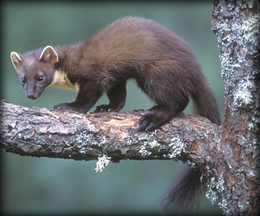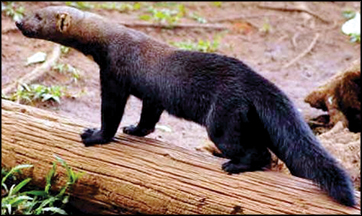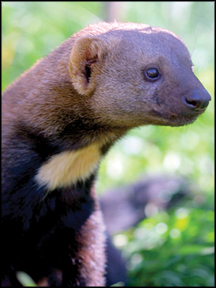
Mustelids:

Rather cute in appearance, pine martens are a species of animal that
belongs to the Mustelid family which includes weasels, otters, skunks,
minks, badgers and wolverines. There are the European pine martens,
North American pine martens and the New Foundland pine martens (the
latter is believed to be a subspecies), to name a few.

 |
|
New Foundland
pine marten |
In general, pine martens are slender-bodied creatures with dense,
brown coloured coats, long bushy tails which help them to balance on
trees, pointed faces somewhat like those of cats, small or large,
rounded ears and brown eyes. On average they are about 19 to 27 inchs in
length with a tail of about five to nine inches. They weigh about one to
three pounds with the males being slightly larger than the females. They
have sensitive ears and sharp teeth too.
The pine martens are agile mammals and are good climbers. They are
the only mustelids with semi-retractable claws, which enable the animals
to live arboreal lifestyles. Like most members of this family, they too
have scent glands under the tail and on the belly.
The European pine marten (Martes, Martes), which is native to
Northern Europe, is the size of a domestic cat - 53 cm (21 inchs) and
has a 25 cm (10 inchs) bushy tail. It weighs 1.5 kg (3.5 lbs) and has a
fur coat which is light brown to reddish brown in colour. The winter
coat is longer and silkier. It has a cream to yellow coloured ‘bib’
shaped patch of fur on its throat area.
Inhabiting mostly well-wooded forests, the European pine marten could
be seen making its den in hollows of trees, scrub covered fields or rock
cavities.
The marten is very active towards dusk and at night; it spends its
time searching the forest floor for food such as rodents, insects and
frogs. Its diet also comprises small mammals, carrion, birds and birds’
eggs, meat, berries and honey.
 |
|
European pine
marten |
European pine marten males are known to be very territorial, marking
their territories with faecal droppings at prominent places within the
area.
As pine martens are prized for their very fine fur, the European pine
marten too is preyed upon by man for its fur coat. Apart from the
humans, they are hunted by red foxes and golden eagles. Loss of habitat
too has contributed greatly to the decline of pine martens in general.
 |
|
North
American pine marten |
The European pine marten which is mature enough to reproduce by three
years, gives birth to a litter of one to five young after a gestation
period of about 30 days. The young, born around March/April, are about
30 grammes in weight and become fully independent by the time they are
six months old.
The North American pine martens (Martes americana), also known as the
American martens which are native to the northern parts of the country,
are different from the fisher species (Martes caurina). Some researchers
say it should be considered as an entirely different species from the
fishers.
With a brown coloured luxuriant fur coat and an irregular shaped
chest pattern in a lighter shade, the North American pine marten could
be seen darting about in mature coniferous or mixed forests in Alaska
and Canada, and also further south, through the Rocky Mountains. With
their long slender bodies, small, round and high ears, pointed snouts
(like in cats) and rather large foot pads in comparison to their bodies,
the North American pine martens are very similar to the European pine
martens in appearance. They have glossy brown fur coats with lighter
throat patches. These omnivorous animals like to eat American red
squirrels and also all the other kinds of food the European pine martens
eat.
They are usually solitary animals except during the breeding season
where they could be seen in pairs.
The males, like the other members of the family, are very
territorial; they have been observed aggressively defending their
territories which extend from one to three square miles. The female
gives birth to between one and five young (sometimes known as kits) in a
den, tree hollow or rock cavity.
 |
|
Most tayras
have either brown or black coloured coats |
The American pine martens are said to be very playful pets,
especially if they are reared when young and bottle-fed.
The New Foundland pine martens (Martes Americana atrata) which is a
subspecies, is considered to be endangered. Very few have seen this
particular species because the numbers have greatly reduced since it was
classed as threatened even way back in 1986.
Presently it is believed that there are only about 300 animals living
in the island. Like all the other martens, this species too is the size
of a house cat, but its coat is very thick, especially in the winter.
The bib like patch is a yellowish orange in colour while the fur on the
rest of the body is brown.
 |
|
The tayras
are very similar to weasels |
The most important prey of the New Foundland pine marten is a small
creature called the meadow vole. It is the only small rodent native to
the island. These tiny rodents generally keep themselves warm in the
cold winter months with the help of snow. So, when there are long, cold
winters with less snowfall, the voles get affected. This in turn has an
impact on the food cycle of the martens who are already threatened due
to over-trapping and loss of habitat.
Another species from the weasel-like family of Mustelidae is the
tayra (Eira barbara). They are also known as tolomuco or perico ligero
in Central America. They are the only members in the genus Eira,
according to researchers.
In appearance, the tayras are very similar to weasels and pine
martens. But, they are somewhat bigger in size and is almost the size of
a medium sized dog. On average, the tayras are 60 cm long from head to
body with a tail which is 45 cm long. Most tayras have either brown or
black coloured coats with a lighter patch on the chest. In some, there’s
a mix of yellowish fur. The fur on the head changes to brown or grey
with age. The colour of the coats too vary according to the geographical
range. Tayras weigh about 5 kg (11 lbs) on average, but the weight
ranges from 2.7 to 7.5 kg (6 to 16.5 lbs) from one animal to another,
among the nine recognised subspecies.
 |
|
The tayras
have wrinkled facial skin |
The tayras have wrinkled facial skin and as a result they are called
the ‘old man’s head’ in indigenous language. The head is broad and the
body is slender with medium length legs (like in martens). The rather
large head in comparison to the size of the body is supported by a long
neck. The ears are round and short. The tail is bushy and the hind feet
are large with long claws, giving it the ability to go up and down trees
nimbly.
The tayras are omnivorous, meaning they eat both meat and plant
matter. Their diet includes guina pigs, mice, squirrels, insects,
fruits, carion and birds. In fact, they eat almost anything and even
climb trees to get at birds and birds’ nests.
They have been observed leaping from treetop to treetop, pursuing
prey. Researchers say that the tayras are expert climbers. They can also
swim well and run fast.
These weasel-like mammals, found in tropical forests of Central
America, South America and the island of Trinidad are considered to be
rather bold among the members of the Muselid family; They are sighted
more often than the rest. As they are attracted to fruits, they
regularly raid fruit orchards.
 Active
both day and night, the tayras rarely rest. They could be seen
travelling alone or in groups in their habitats. They live in hollows of
trees, burrows in the ground or nests of tall grass. When alarmed, the
tayras give a short barking call and immediately seek protection in a
hollow of a tree. Active
both day and night, the tayras rarely rest. They could be seen
travelling alone or in groups in their habitats. They live in hollows of
trees, burrows in the ground or nests of tall grass. When alarmed, the
tayras give a short barking call and immediately seek protection in a
hollow of a tree.
The females give birth to two to three babies after a gestation
period of 60 to 70 days. Not much is known about their reproduction and
young, but researchers claim the young are born with their eyes closed
and take a long time to open them.
All the other members of the mustelid family have the ability to
delay implantation (embryonic diapause) according to researchers. This
is the ability to delay embryonic development; the birth of young taking
place only when environmental factors are favourable for the young.
However, the tayras are not able to do so, say researchers, going by the
studies they’ve carried out so far.
As tayras are playful creatures which could be tamed easily, most
people keep them as pets the way some of us rear or mongoose as pets.
We’ll bring you interesting facts about more hitherto unknown
creatures in our future issues. Keep learning about our friends in the
wild because they are part of the planet and help keep the balance of
the eco-system.
|
